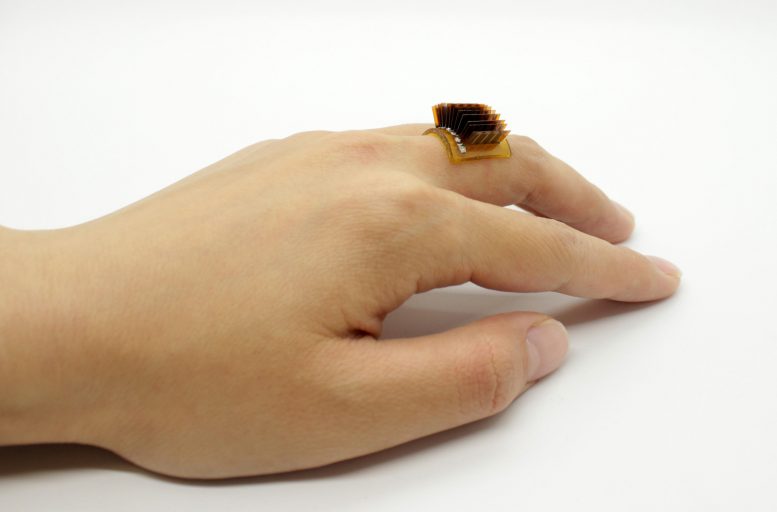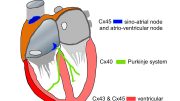Researchers at CU Boulder have developed a new, low-cost wearable device that transforms the human body into a biological battery.
The device, described in the journal Science Advances, is stretchy enough that you can wear it like a ring, a bracelet, or any other accessory that touches your skin. It also taps into a person’s natural heat—employing thermoelectric generators to convert the body’s internal temperature into electricity.
“In the future, we want to be able to power your wearable electronics without having to include a battery,” said Jianliang Xiao, senior author of the new paper and an associate professor in the Paul M. Rady Department of Mechanical Engineering at CU Boulder.
The concept may sound like something out of The Matrix film series, in which a race of robots have enslaved humans to harvest their precious organic energy. Xiao and his colleagues aren’t that ambitious: Their devices can generate about 1 volt of energy for every square centimeter of skin space—less voltage per area than what most existing batteries provide but still enough to power electronics like watches or fitness trackers.
Scientists have previously experimented with similar thermoelectric wearable devices, but Xiao’s is stretchy, can heal itself when damaged and is fully recyclable—making it a cleaner alternative to traditional electronics.
“Whenever you use a battery, you’re depleting that battery and will, eventually, need to replace it,” Xiao said. “The nice thing about our thermoelectric device is that you can wear it, and it provides you with constant power.”
High-tech bling
The project isn’t Xiao’s first attempt to meld human with robot. He and his colleagues previously experimented with designing “electronic skin,” wearable devices that look, and behave, much like real human skin. That android epidermis, however, has to be connected to an external power source to work.
Until now. The group’s latest innovation begins with a base made out of a stretchy material called polyimine. The scientists then stick a series of thin thermoelectric chips into that base, connecting them all with liquid metal wires. The final product looks like a cross between a plastic bracelet and a miniature computer motherboard or maybe a techy diamond ring.
“Our design makes the whole system stretchable without introducing much strain to the thermoelectric material, which can be really brittle,” Xiao said.
Just pretend that you’re out for a jog. As you exercise, your body heats up, and that heat will radiate out to the cool air around you. Xiao’s device captures that flow of energy rather than letting it go to waste.
“The thermoelectric generators are in close contact with the human body, and they can use the heat that would normally be dissipated into the environment,” he said.
Lego blocks
He added that you can easily boost that power by adding in more blocks of generators. In that sense, he compares his design to a popular children’s toy.
“What I can do is combine these smaller units to get a bigger unit,” he said. “It’s like putting together a bunch of small Lego pieces to make a large structure. It gives you a lot of options for customization.”
Xiao and his colleagues calculated, for example, that a person taking a brisk walk could use a device the size of a typical sports wristband to generate about 5 volts of electricity—which is more than what many watch batteries can muster.
Like Xiao’s electronic skin, the new devices are as resilient as biological tissue. If your device tears, for example, you can pinch together the broken ends, and they’ll seal back up in just a few minutes. And when you’re done with the device, you can dunk it into a special solution that will separate out the electronic components and dissolve the polyimine base—each and every one of those ingredients can then be reused.
“We’re trying to make our devices as cheap and reliable as possible, while also having as close to zero impact on the environment as possible,” Xiao said.
While there are still kinks to work out in the design, he thinks that his group’s devices could appear on the market in five to 10 years. Just don’t tell the robots. We don’t want them getting any ideas.
Reference: “High-performance wearable thermoelectric generator with self-healing, recycling, and Lego-like reconfiguring capabilities” by Wei Ren, Yan Sun, Dongliang Zhao, Ablimit Aili, Shun Zhang, Chuanqian Shi, Jialun Zhang, Huiyuan Geng, Jie Zhang, Lixia Zhang, Jianliang Xiao and Ronggui Yang, 10 February 2021, Science Advances.
DOI: 10.1126/sciadv.abe0586
Coauthors on the new paper include researchers from China’s Harbin Institute of Technology, Southeast University, Zhejiang University, Tongji University and Huazhong University of Science and Technology.










“Their devices can generate about 1 volt of energy” Volts is not energy.
Much of this technology is present in already available consumer technology. For example, check out the PowerWatch: http://www.powerwatch.com
So the closer the 2 side are to each other in temp. The less efficient it becomes. I played around with this idea years ago. In the end, not an efficient energy source.
Why would someone want to wear something that’s gonna turn your body into a conductor rain storm hit you are a walking time bomb
“1 volt of energy” – sorry, but without also indicating how many amps it can provide, saying 1 volt like this is meaningless. 1 volt at 1 amp is way more power than 1 volt at 1 milliamp. 1000x as much.
I’m not impressed, they can invent this. Invent a cure for cancer, invent a way to end this pandemic and bring things back to normal. Impress me with that.
Baby steps. Next diodes amps resistors for higher/lower energy flux:) positive words for doers
When I had to wear a dozen chest EKG sensors with all those wires going to a portable pack for a week in hospital, I wondered if anyone had built individual EKG sensors that can bluetooth to the sensor pack. The current hospital tech is really 20 years behind what is possible. If I was engineering that tech I sure wouldn’t choose this TEG device, it would have to be flush to the skin so no entangling in clothing. Probably stick with single use button battery cells which hospitals go through like crazy or maybe a piezo effect cell.
The max power these TEGs are going to produce that might be practical is a few mW, enough only for sensors. Laptops or phones would be 1000s times too much load.
As for the article, the graphics are stupid like those awful Kurzgesagt youtubes, these are moronic to watch.
Laptops typically use 3-10W or so unless they are running 8 core gaming laptops from the wall or during the initial charge inrush when the battery is empty. Get a Killawatt device to see what power levels devices usually use.
engineer speaking
Seems like most of the readers of this article are either too lazy or enjoy commenting on the very obvious more than actually acquiring the facts.
Every high schooler with an iota of interest knows that a volt is a measure of potential yes yes, but if you bothered to click the actual source and read it you would know that the device is capable of generating 19 μW/cm2 at 1 volt. This at a temperature differential of only 95 Kelvin, which is actually quite a leap, performance-wise, as I understand it.
And if developing TEGs capable of working in the temperature ranges suitable for use in harvesting of biological waste heat doesn’t impress you or doesn’t strike you as “efficient” then there is a very logical explanation for this; It’s because you’re ignorant of the potential ramifications.